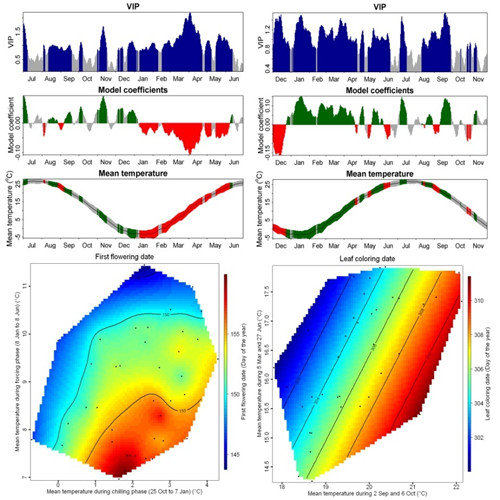Climate change is affecting the phenology of plants and animals throughout the world, but few studies have evaluated the climatic response of fruit trees in East Asia. Specifically, the response of fruit tree phenology to warming during different parts of the year has not been explored. XU Jianchu’s group, from Kunming Institute of Botany, evaluated long-term records (1963-2008) of chestnut first flowering, leaf coloring and growing season lengths from Beijing, China. Phenological dates were compared with daily temperatures for the 12 months leading up to the respective events, using Partial Least Squares (PLS) regression.
The results indicate that 1) First flowering dates in Beijing advanced by 1.6 days per decade over the length of the record, whereas leaf coloring showed no significant trend. The growing season expanded by 4.3 days per decade. 2) First flowering was advanced by high temperatures between January and June, but delayed by warm conditions during the chill accumulation phase (late October through early January). 3) Leaf coloring was advanced by warm conditions during most of the growing season, but delayed by high temperatures in fall. 4) Variation in the length of the growing season was strongly correlated to variations in spring phenology. 5) Further warming may shift and eventually lead to substantial changes in plant responses to warming, i.e. warming during the chilling phase could reduce chilling accumulation of fruit trees, delay dormancy release, and cause uneven and delayed flowering leading to crop yield loss and even failure.
This research was led by Prof. XU Jianchu, and supported by the National Natural Science Foundation of China (NSFC)’s project on “Response of Rhododendron arboreum Smith to climate change in Eastern Himalaya” (No: 31270524) and another Key Project of NSFC (No: 41030101). Further support was supplied by the Consultative Group on International Agricultural Research Program 6: Forests, Trees, and Agroforestry, and Research Program 7: Climate Change, Agriculture and Food Security. Dr. DAI Junhu from the Institute of Geographic Sciences and Natural Resource Research at CAS and Dr. Eike Luedeling from the Headquarter of World Agroforestry Center also made great contributions to this research.
This work “Response of chestnut phenology in China to climate variation and change”. has been accepted for publication in Agricultural and Forest Meteorology 180 (2013):164-172 (Top 1 journal in Forestry; IF3.42).

Fruit tress phenology to climate changes




